
An effects unit or effects pedal is an electronic device that alters the sound of a musical instrument or other audio source through audio signal processing.

The Hammond organ is an electric organ invented by Laurens Hammond and John M. Hanert and first manufactured in 1935. Multiple models have been produced, most of which use sliding drawbars to vary sounds. Until 1975, Hammond organs generated sound by creating an electric current from rotating a metal tonewheel near an electromagnetic pickup, and then strengthening the signal with an amplifier to drive a speaker cabinet. The organ is commonly used with the Leslie speaker.

The Rhodes piano is an electric piano invented by Harold Rhodes, which became popular in the 1970s. Like a conventional piano, the Rhodes generates sound with keys and hammers, but instead of strings, the hammers strike thin metal tines, which vibrate next to an electromagnetic pickup. The signal is then sent through a cable to an external keyboard amplifier and speaker.

Vox is a musical equipment manufacturer founded in 1957 by Thomas Walter Jennings in Dartford, Kent, England. The company is most famous for making the Vox AC30 guitar amplifier, used by The Beatles, The Rolling Stones, The Kinks, The Yardbirds, Queen, Dire Straits, U2, and Radiohead; the Vox Continental electric organ, the Vox wah-wah pedal used by Jimi Hendrix, and a series of innovative electric guitars and bass guitars. Since 1992, Vox has been owned by the Japanese electronics firm Korg.

The Leslie speaker is a combined amplifier and loudspeaker that projects the signal from an electric or electronic instrument and modifies the sound by rotating a baffle chamber ("drum") in front of the loudspeakers. A similar effect is provided by a rotating system of horns in front of the treble driver. It is most commonly associated with the Hammond organ, though it was later used for the electric guitar and other instruments. A typical Leslie speaker contains an amplifier, a treble horn and a bass speaker—though specific components depend upon the model. A musician controls the Leslie speaker by either an external switch or pedal that alternates between a slow and fast speed setting, known as "chorale" and "tremolo".
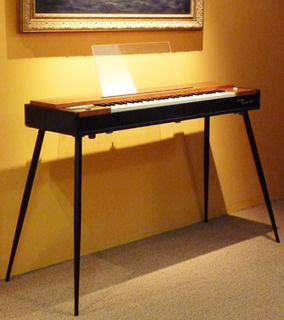
The Clavinet is an electrically amplified clavichord invented by Ernst Zacharias and manufactured by the Hohner company of Trossingen, West Germany, from 1964 to 1982. The instrument produces sounds by a rubber pad striking a point on a tensioned string, and was designed to resemble the Renaissance-era clavichord.
Farfisa is a manufacturer of electronics based in Osimo, Italy, founded in 1946. The company manufactured a series of compact electronic organs in the 1960s and 1970s, including the Compact, FAST, Professional and VIP ranges, and later, a series of other keyboard instruments. They were used by a number of popular musicians including Sam the Sham, Pink Floyd, Sly Stone, Blondie, and the B-52s.

The Hohner Pianet is a type of electro-mechanical piano built by the Hohner company of Trossingen, West Germany and designed by Ernst Zacharias. The Pianet was a variant of his earlier reed-based Hohner electric piano, the Cembalet, which, like the Pianet, was intended for home use. Hohner offered both keyboards in their range until 1968. The Pianet production consisted of two distinctly different mechanism groups with characteristically different sound. The first group, lasting from introduction to 1977, had ground stainless steel reeds, a pick-up using variable capacitance, and leather-faced activation pads. The second group from 1977 until the end of production used rolled spring-steel reeds, electro-magnetic pick-ups, and moulded silicone rubber activation pads.
Keyboard expression is the ability of a keyboard musical instrument to change tone or other qualities of the sound in response to velocity, pressure or other variations in how the performer depresses the keys of the musical keyboard. Expression types include:
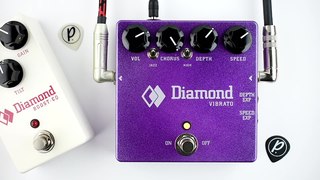
A vibrato unit is an electronic effects unit used to add vibrato to the sound of an electric instrument, most often an electric guitar. Vibrato units may be individual stomp boxes or built into multi-effects units, but are traditionally built into guitar amplifiers. Vibrato units are particularly used in surf music.
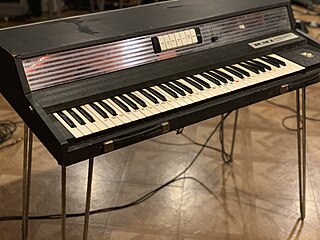
Rocky Mount Instruments (RMI) was a subsidiary of the Allen Organ Company, based in Rocky Mount, North Carolina, active from 1966 to 1982. The company was formed to produce portable musical instruments, and manufactured several electronic pianos, harpsichords, and organs that used oscillators to create sound, instead of mechanical components like an electric piano.

The Wurlitzer electronic piano is an electric piano manufactured and marketed by Wurlitzer from the mid-1950s to mid-1980s. Sound is generated by striking a metal reed with a hammer, which induces an electric current in a pickup. It is conceptually similar to the Rhodes piano, though the sound is different.

The Vox Continental is a transistorised combo organ that was manufactured between 1962 and 1971 by the British musical equipment manufacturer Vox. It was designed for touring musicians and as an alternative to the heavy Hammond organ. It supports drawbars in a similar manner to the Hammond, and has distinctive reverse-coloured keys. The sound is generated by a series of oscillators, using a frequency divider to span multiple octaves.

The Fender Twin and Twin Reverb are guitar amplifiers made by Fender Musical Instruments Corporation. The Twin was introduced in 1952, two years before Fender began selling Stratocaster electric guitars. The amps are known for their characteristically clean tone.
A combo organ, so-named and classified by popular culture due to its original intended use by small, touring jazz, pop and dance groups known as "combo bands", as well as some models having "Combo" as part of their brand or model names, is an electronic organ of the frequency divider type, generally produced between the early 1960s and the late 1970s. This type of organ predated, and contributed largely to, the development of modern synthesizers. The combo organ concept, at least in the context of mass-production, is thought to have arisen from popular demand, when smaller home organs were seen in music stores. Combo organs were probably originally developed in the United Kingdom, based on the Univox polyphonic version of the Clavioline, and some models included the inner-workings of Italian-made transistor accordions. They were the brainchild of necessity for portable organs of simple design, mainly for use in these small groups. Combo organs ended up having a major impact on the music scene of the mid- and late 1960s, particularly on rock and roll of that era.

The Gibson G-101,, is a transistorised combo organ, manufactured in the late 1960s by the Lowrey Organ Company in the late 1960s. It was also known as the Kalamazoo K-101. It provided a 61-key manual with a variety of stops accessed by rocker switches and a separate bass system.

The Doric Transistorized Organ is a model of combo organ produced in Italy in the 1960s.

This is a list of jazz and popular music terms that are likely to be encountered in printed popular music songbooks, fake books and vocal scores, big band scores, jazz, and rock concert reviews, and album liner notes. This glossary includes terms for musical instruments, playing or singing techniques, amplifiers, effects units, sound reinforcement equipment, and recording gear and techniques which are widely used in jazz and popular music. Most of the terms are in English, but in some cases, terms from other languages are encountered.
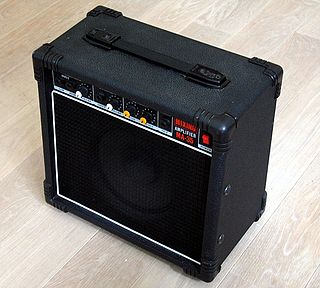
A keyboard amplifier is a powered electronic amplifier and loudspeaker in a wooden speaker cabinet used for amplification of electronic keyboard instruments. Keyboard amplifiers are distinct from other types of amplification systems such as guitar amplifiers due to the particular challenges associated with making keyboards sound louder on stage; namely, to provide solid low-frequency sound reproduction for the deep basslines which keyboards can play and crisp high-frequency sound for the high-register notes. Another difference between keyboard amplifiers and guitar/bass amplifiers is that keyboard amps are usually designed with a relatively flat frequency response and low distortion. In contrast, many guitar and bass amp designers purposely make their amplifiers modify the frequency response, typically to "roll off" very high frequencies, and most rock and blues guitar amps, and since the 1980s and 1990s, even many bass amps are designed to add distortion or overdrive to the instrument tone.
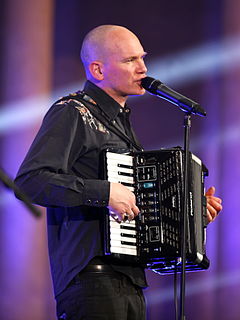
A digital accordion is an electronic musical instrument that uses the control features of a traditional accordion to trigger a digital sound module that produces synthesized or digitally sampled accordion sounds or, in most instruments, a range of non-accordion sounds, such as orchestral instruments, pipe organ, piano, guitar, and so on. Digital accordions typically encode and transmit key presses and other input as Musical Instrument Digital Interface (MIDI) messages. Most digital accordions need to be plugged into a keyboard amplifier or PA system to hear their sounds.


















